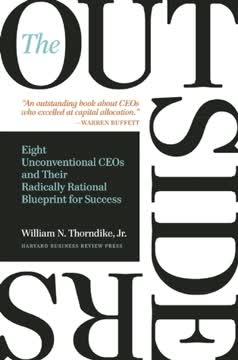重点摘要
1. 价值投资:购买被低估证券的艺术
价值投资易于理解但难以实施。
核心原则。 价值投资涉及以显著折扣购买证券,这需要对商业基本面有深刻理解,并能够识别市场中被错误定价的资产。
关键要素:
- 详尽的财务报表分析
- 对竞争优势和行业动态的评估
- 耐心等待合适的机会
- 避免为资产支付过高价格的纪律
价值投资者关注长期回报而非短期市场波动。他们寻找具有强大基本面、稳定现金流和有能力管理团队的企业。通过购买被低估的证券,价值投资者创造了一个安全边际,保护他们的投资免受潜在的下行风险。
2. 机构投资的陷阱和华尔街的短期关注
大多数机构投资者受到短期相对业绩导向的困扰,缺乏退休和捐赠基金应有的长期视角。
机构约束。 许多专业投资者面临着在季度或年度内超越基准和同行的压力。这种短期关注往往导致次优的投资决策,未能抓住长期价值机会。
华尔街的偏见:
- 强调季度收益和短期价格波动
- 倾向于跟随潮流和追逐流行趋势
- 投资银行与其客户之间的利益冲突
- 过度依赖简单的估值指标和财务模型
个人投资者可以通过采用长期视角和专注于基本面分析来获得优势,而不是被短期市场噪音所左右。通过避免机构投资的陷阱,价值投资者可以识别出其他人忽视或误解的机会。
3. 安全边际:风险规避投资的基石
成为价值投资者,你必须以低于内在价值的价格购买。这使其成为一个绝对的价值。
风险缓解。 安全边际是证券价格与其估计内在价值之间的差异。通过以显著折扣购买资产,投资者创造了一个缓冲,防止潜在损失,并增加了实现优异回报的机会。
安全边际的好处:
- 防止估值错误或意外事件
- 增加资本增值的潜力
- 在市场下跌时减少下行风险
- 更大的灵活性以长期持有投资
安全边际的大小应与投资的感知风险成比例。高风险机会需要更大的安全边际,而更稳定的投资可能只需较小的折扣。
4. 企业估值:价值投资者的关键技能
企业价值无法精确确定。
估值方法。 投资者必须采用各种技术来估计企业的内在价值,认识到估值是一门不精确的艺术,而不是精确的科学。
关键估值方法:
- 折现现金流分析
- 可比公司分析
- 基于资产的估值
- 清算价值评估
成功的价值投资者对企业估值有着细致入微的理解,考虑定量和定性因素。他们认识到每种估值方法的局限性,并使用多种方法来综合出合理的内在价值估计。通过专注于保守估计并保持安全边际,投资者可以减轻企业估值中的固有不确定性。
5. 在市场低效中识别价值机会
好的投资想法是稀有而有价值的东西,必须勤奋地挖掘出来。
市场异常。 价值投资者在市场中被忽视、误解或暂时不受欢迎的领域寻找机会。这些低效通常由于机构约束、投资者心理或需要深入分析的复杂情况而产生。
潜在的价值机会来源:
- 分拆和企业重组
- 财务困境证券
- 小盘股和微盘股
- 特殊情况(如并购套利、清算)
通过在特定领域发展专业知识并保持逆向思维,价值投资者可以识别出其他人错过的机会。这种方法需要勤奋的研究、耐心和在潜在回报值得冒险时逆势而行的意愿。
6. 实现投资价值的催化剂的力量
实现内在价值的催化剂有助于降低风险。
价值实现。 催化剂是帮助弥合证券市场价格与其内在价值之间差距的事件或情况。通过识别潜在的催化剂,投资者可以增加成功的机会,并减少其投资论点实现所需的时间。
催化剂类型:
- 企业行动(如股票回购、资产出售)
- 管理层或所有权的变更
- 行业整合或监管变化
- 业务表现或市场条件的改善
投资者应寻找存在多个潜在催化剂的机会,因为这增加了价值实现的可能性。然而,必须保持耐心,避免强求可能不会实现的催化剂,因为这可能导致过早卖出或过度的投资组合周转。
7. 投资困境证券:高风险,高回报
投资财务困境和破产证券需要耐心等待合适的情况、合适的证券和合适的价格,并坚持价值投资标准的纪律。
危机中的机会。 困境证券由于投资者恐惧、被迫出售和复杂情况,通常以显著折扣交易。这为具有专业知识和风险承受能力的投资者创造了机会,以应对这些具有挑战性的投资。
困境投资的关键考虑因素:
- 详尽的资本结构和债权人优先级分析
- 潜在恢复情景的评估
- 对破产和重组过程的理解
- 对管理层扭转业务能力的评估
虽然困境投资可以提供可观的回报,但也伴随着显著的风险。投资者必须准备好应对潜在损失,并有耐心等待重组过程的展开。在投资困境证券时,分散投资和头寸规模管理对于管理整体投资组合风险至关重要。
8. 投资组合管理:平衡风险和回报
投资组合管理是投资者降低风险的另一种手段。
风险管理。 有效的投资组合管理不仅仅是选择个别投资。它需要一种整体方法来平衡整个投资组合的风险和回报。
投资组合管理的关键方面:
- 在各个行业和资产类别中适当分散投资
- 监控和重新平衡头寸
- 管理投资组合的流动性和现金流
- 在适当时实施对冲策略
投资者应努力实现一种分散程度,既能减少特定风险,又不稀释其最佳想法。通过保持平衡的投资组合并积极管理风险敞口,投资者可以提高整体风险调整后的回报,并增加抓住新机会的能力。
9. 价值投资中的耐心和纪律的重要性
投资者应谨慎做出保守的预测,然后仅在从中得出的估值有显著折扣时进行投资。
长期关注。 在价值投资中取得成功需要耐心等待真正有吸引力的机会,并在市场情绪普遍不利时坚持严格的投资过程。
成功的价值投资者的关键特质:
- 在吸引机会稀缺时愿意持有现金
- 能够承受短期表现不佳
- 持续学习和改进投资技能
- 在市场波动面前保持情绪控制
通过保持长期视角并专注于其投资的基本面,价值投资者可以避免短期思维和情绪决策的陷阱。这种方法使他们能够利用市场低效并在长期内实现优异的风险调整回报。
最后更新日期:
FAQ
What's Margin of Safety about?
- Value Investing Focus: Margin of Safety by Seth A. Klarman centers on risk-averse value investing strategies, advocating for buying securities at a discount to their intrinsic value.
- Avoiding Pitfalls: It highlights common investor mistakes like speculation and emotional trading, offering strategies to avoid these traps.
- Long-Term Success: The book promotes a disciplined, long-term approach to investing, prioritizing sustainable success over short-term gains.
Why should I read Margin of Safety?
- Expert Insights: Klarman, a renowned investor, shares invaluable insights into value investing, beneficial for both novices and seasoned investors.
- Timeless Principles: The principles are applicable across various market conditions, making the book relevant regardless of current trends.
- Capital Preservation: Emphasizes the importance of preserving capital and avoiding losses, crucial for long-term investment success.
What are the key takeaways of Margin of Safety?
- Margin of Safety Concept: Klarman stresses buying securities below intrinsic value to protect against judgment errors.
- Investing vs. Speculation: Differentiates investing, based on fundamentals, from speculation driven by trends and emotions.
- Discipline and Patience: Successful investing requires waiting for the right opportunities and holding investments until value is realized.
What is the concept of "margin of safety" in Margin of Safety?
- Definition: It's the difference between a security's intrinsic value and its market price, central to value investing.
- Risk Mitigation: Provides a buffer against errors and unforeseen market events, reducing the likelihood of permanent capital loss.
- Practical Application: Involves calculating intrinsic value and identifying securities trading below this value, requiring disciplined analysis.
How does Seth A. Klarman define value investing in Margin of Safety?
- Buying at a Discount: Value investing involves purchasing securities at a significant discount from their intrinsic value to minimize risk.
- Focus on Fundamentals: Requires thorough analysis of a company's fundamentals to determine its true worth, avoiding reliance on market trends.
- Long-Term Perspective: Emphasizes a long-term view, as market recognition of undervalued securities may take time.
What are the common pitfalls investors face according to Margin of Safety?
- Speculation vs. Investment: Confusing speculation with investment leads to poor decisions based on short-term movements.
- Emotional Trading: Emotions like greed and fear can cloud judgment, causing irrational decisions and losses.
- Ignoring Fundamentals: Overlooking business fundamentals in favor of price movements can result in significant financial mistakes.
How does Klarman suggest investors should approach risk in Margin of Safety?
- Avoiding Loss is Key: The primary goal should be avoiding losses, not just achieving high returns, crucial for long-term success.
- Assessing Risk vs. Return: Evaluate risk independently from potential return, ensuring expected return justifies the risk.
- Margin of Safety: Investing with a margin of safety protects against market fluctuations and judgment errors.
How does Margin of Safety address the concept of risk?
- Comprehensive Risk Assessment: Risk should be assessed considering both market volatility and business fundamentals, beyond traditional metrics like beta.
- Permanent Loss Focus: Emphasizes focusing on the risk of permanent loss rather than short-term price fluctuations.
- Investor Behavior: Discusses how behavior influences risk perception, encouraging rational and disciplined responses to market movements.
What are the best quotes from Margin of Safety and what do they mean?
- "Avoid losing money": Capital preservation is paramount, reminding investors that protecting assets is as important as making money.
- "Expect price fluctuations": Investors should tolerate volatility, understanding it's crucial for long-term success.
- "Sell when you want": Highlights the importance of liquidity and flexibility, allowing strategic decisions rather than forced actions.
How does Klarman view market volatility in Margin of Safety?
- Volatility as Opportunity: Sees market volatility as a chance to acquire undervalued securities due to irrational reactions.
- Temporary vs. Permanent Loss: Distinguishes between temporary price changes and permanent value loss, focusing on the latter.
- Expecting Fluctuations: Advises investors to be prepared for price fluctuations, reconsidering strategies if volatility is intolerable.
What strategies does Klarman recommend for finding attractive investments in Margin of Safety?
- Bottom-Up Approach: Focus on individual securities through thorough fundamental analysis, rather than macroeconomic trends.
- Catalysts for Value Realization: Look for triggers like corporate actions or market changes that can realize underlying value.
- Market Inefficiencies: Seek out mispriced securities due to irrational behavior or lack of information, uncovering hidden market opportunities.
How does Klarman suggest managing a portfolio in Margin of Safety?
- Diversification Importance: Mitigate risk with a well-diversified portfolio, holding a manageable number of securities for deep understanding.
- Liquidity Management: Maintain liquidity to seize new opportunities, balancing liquid and illiquid investments for optimal returns.
- Regular Review: Regularly review and rebalance the portfolio to align with investment goals and adjust to market conditions.
评论
《安全边际》被誉为现代价值投资的经典之作,尽管有些人认为它有些过时。读者们赞扬克拉曼对价值投资原则的清晰解释、对风险管理的重视以及对市场低效的洞察。许多人认为它比格雷厄姆的《聪明的投资者》更胜一筹,因为它的写作简洁明了。批评者指出其中一些过时的例子,并不同意某些建议。尽管已绝版,投资者们仍然追寻这本书,因为它在纪律严明、逆向投资和资本保全方面提供了永恒的智慧。
Similar Books














